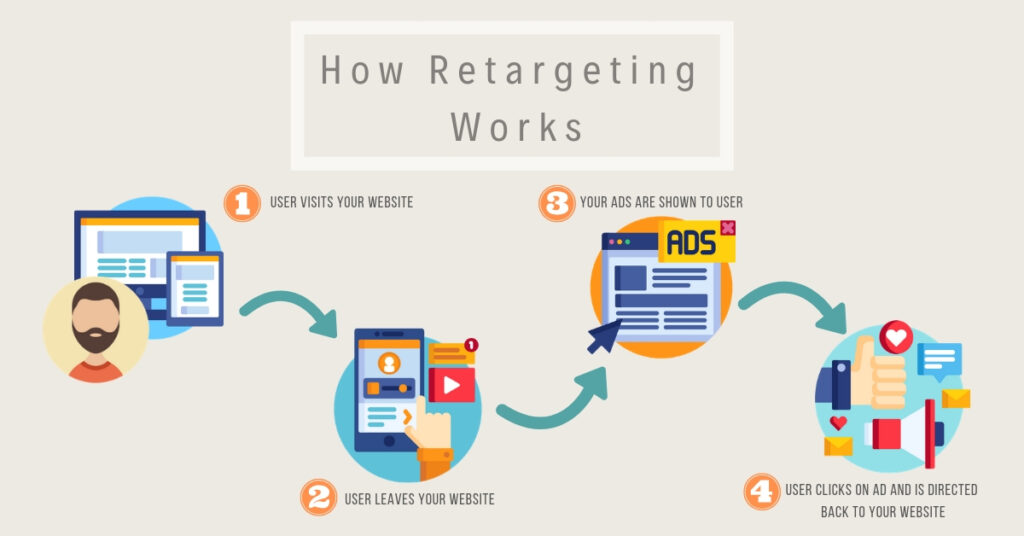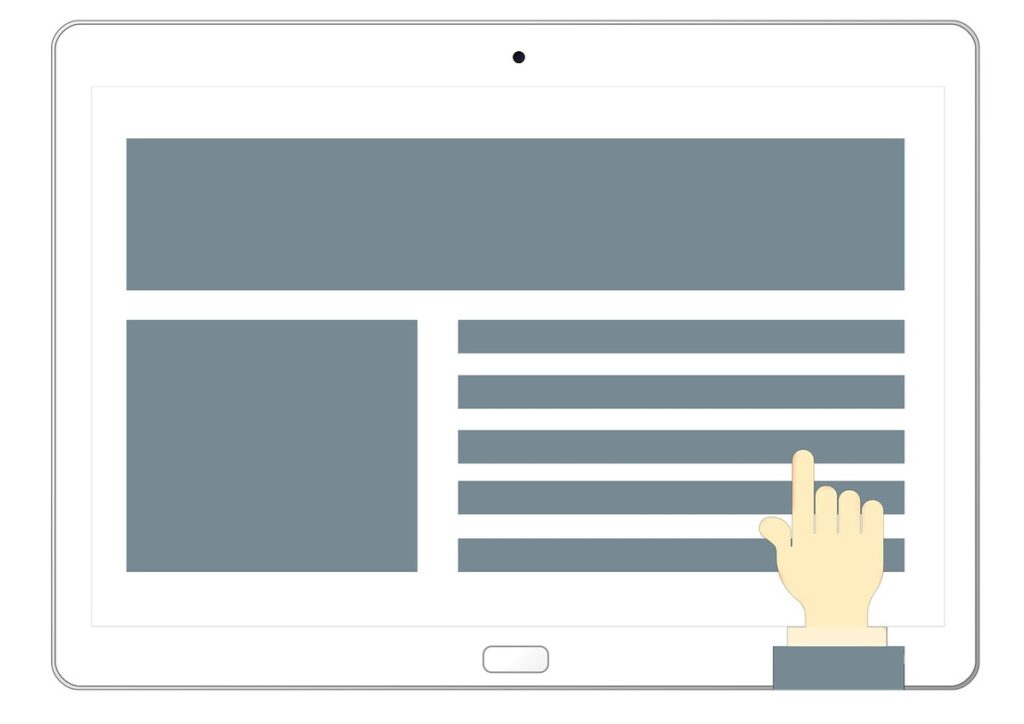Did you know that an overwhelming majority of web users never visit a website twice? (97% of them according to MailChimp). Such missed opportunities are just as many net losses for companies that make earnest efforts – and considerable investments – to generate traffic. How can you counter this issue? How can you capitalize on the countless users who show up only to disappear immediately and attempt to “recapture” at least some of them?
Retargeting provides a solution. Ad retargeting is a technique that gives users a second chance to complete the action they began but gave up on. It offers companies an opportunity to improve their conversion rate significantly. Let’s delve deeper into the secrets of a successful retargeting campaign!

What Is Retargeting, Exactly?
A user just viewed a product page on your eCommerce website and added the item to their basket. Yet after a few minutes, they left the platform… without completing their purchase. Is this prospect lost forever? No, you can still get them back! And that’s what retargeting is all about.
Retargeting marketing is a targeted advertising technique used by marketers across many industries. It consists in identifying users who showed interest in a product, service, or brand, and targeting them through suitable advertising campaigns. By clicking the banner ads or links they come across while browsing the web, they get sent to pages that match their previous visits. It encourages them to pursue their interest further.

(Source: Just Digital Inc)
The most common form of retargeting is the one eCommerce professionals rely on. You have most likely come across it yourself: After looking up an item on a web shop, you are suddenly seeing ads for this exact product everywhere on the Internet. You’ve been eyeing a beautiful pair of sneakers? There’s a good chance they’ll be following you around long after this initial contact!
By leaning on the behavioural data they gather from the users’ browsing history, companies give themselves another opportunity to convince them to convert. And while this technique is prevalent in retail, other industries can put it to good use as well, as shown in the graph below.

(Source: Truelist)
THE VARIOUS FORMS OF RETARGETING
Let’s get one thing clear: Retargeting is an approach to online advertising, not one single method. There actually exist multiple forms of retargeting.
- Standard retargeting – or Display Ads (Google Retargeting Ads) – refers to generic ads being shown on the Display network (a group of websites, applications, and videos where ads are shown, reaching over 90% of all Internet users around the world, according to Google). Banners are displayed based on their relevance to the users’ browsing history (the websites they visited over the past few days). This is the most widely used retargeting channel.
- Social retargeting relies on the same principles as Display Ads but shows the ads in the users’ social media feeds and on these networks’ partnering sites. This channel requires the integration of a Facebook pixel within your website.
- Video retargeting – as the name suggests – focuses on displaying retargeting ads in the videos that the users watch, particularly on YouTube.
- Email retargeting sets itself apart due to the level of customization it offers. It consists in sending out an email that will encourage the user to complete the interrupted action or to keep progressing down the path to purchase. Of course, this implies that you already have the user’s email address, along with their consent – which is why it has become less prominent ever since the GDPR went into effect. When used correctly, this method can be particularly effective since it addresses the users by name. This means you can send them promo codes and vouchers or suggest other products or services they may like if they have already completed a purchase before. Note that this emailing technique is usually called “remarketing”, since it typically targets existing customers. Retargeting marketing, on the other hand, targets contacts that haven’t completed a purchase yet.
- Dynamic retargeting consists not in creating generic ads, but in using customized communication, making it more suitable for the users being targeted (see below the difference between dynamic and static retargeting). Needless to say, this technique offers a high potential for conversion.
How Does Retargeting Work?
Ad retargeting boils down to a simple principle: Addressing users who already did (or were about to do) what was expected of them. This implies that you need to be able to analyze their behaviour by collecting relevant information. There are two solutions that can help you achieve this: you can place a tracking tag in the pages of your website, or you can import an email list to your advertising platform.
RETARGETING USING TAGS
In most cases, retargeting requires small pieces of code known as “pixels” or “tracking tags” which are places on the web pages that need to be monitored, as well as third-party cookies saved by the browser. This process makes it possible to display ads aimed at anonymous users, whose identity you don’t know and whose contact information you do not possess. The object of the ad is integrated on the fly by combining a template in the right format with customized elements related to the item or service they looked up.
Here’s how it works in more concrete terms:
- A user visits a specific page on your website. Their browser receives a cookie, where it stores information regarding this person’s browsing thanks to a tracking tag installed on the page. They then leave the website, having performed no action.
- The data is sent to the advertising platform (Google Retargeting Ads, Facebook Retargeting Ads, etc.) where you launched your campaign. These platforms own a large amount of advertising space on third-party websites and applications and offer various ad formats to choose from.
- Banners related to the page being visited are generated automatically, and then displayed on websites that belong to the network owned by the advertising platform. When people browse these sites, they see a targeted ad featuring the product they viewed on the first website.
- The user clicks the banner ad and is directed to your website – or more specifically to the page they visited before (a product page, their basket, etc.) or to a page that relates to the item they’re interested in. This allows them to pick up where they left off or to perform another action.

The main benefit is that the process is instantaneous and automated. A user can be retargeted the second they leave your website. It can also easily apply to one or several pages of your choice, and it allows you to program campaigns based on such or such behaviour from the user.
RETARGETING USING A DATABASE
The tracking tag/cookie combination is not the only way to practice retargeting. As stated above, retargeting also consists in sending out personalized emails, which implies the existence of a database containing the necessary contact information.
Advertising platforms integrate this custom audience feature. All you need to do is upload a list of email addresses when setting up the remarketing ad campaign. The platform will use it to identify the users it should serve ads to. This offers significant perks because the banner ads in question can be highly customized, and you get to decide who receives what.
What Is Retargeting Used For?
Retargeting marketing has undoubtedly become a major lever. But what objectives can it achieve, exactly? Let’s take a look.
RETARGETING TO IMPROVE YOUR REPUTATION
Have you heard of exposure bias? This cognitive bias boils down to one simple principle: The more someone is exposed to a stimulus (for example, a product or brand), the higher the probability that they will develop positive feelings towards the stimulus.
In other words, if an Internet user sees the same product or the same brand repeatedly, then they will likely become more and more interested in it. This is how retargeting helps you improve the status of your company, brand, products, or services in the mind of the users – until this knowledge turns into trust. As it turns out, 58% of potential customers on the web recognize ads for products they already looked at on different sites (Content Writers).

RETARGETING TO BOOST CONVERSION
A user left your website without performing any actions? Retargeting is an excellent way to get them to come back – and, why not, encourage them to finish what they started. All you need to do is try and bolster their interest in the product or service they already looked up on. This can be done by…
- Reminding the user that they have an unfinished action. They may have given up on their basket because they didn’t have the time to validate it, or because they were interrupted, etc. Sometimes, all it takes is a little reminder to get that conversion! It’s worth noting that 7 users out of 10 put items in a shopping basket and never complete their purchase (Baymard Institute study). It just so happens retargeting reduces the cart abandonment rate by 6.5% on average (MotoCMS).
- Counting on exposure bias (see above). If they see the product or service again, the users may well decide to purchase it.
- Offering free resources, such as a white paper, a tutorial showing how to use the item, a case study, etc. The idea is to convince the user that the product or service is likely to meet their needs.
- Targeting a user who spent time on a specific page, which is undeniable proof that they are interested.
- Sending out a promotional offer which may spark the user’s interest. Perhaps they found these shoes a little too expensive, but a code for 10% off will be enough to make them change their mind.
According to ReadyCloud, a well-orchestrated retargeting campaign could boost your conversion rate by 147%!
RETARGETING TO PROMOTE REPURCHASING
Ad retargeting isn’t just for users who didn’t complete an action. It can also be applied to those who have, in fact, already bought something. The idea is to encourage them to do so again through what is known as upselling (selling a more advanced version of the same product/service) or cross-selling (selling products/services that complement the initial purchase based on previous orders).
Repurchasing improves a user’s Customer Lifetime Value, which is their value over the entire course of their relationship with the brand. And customers are all for it! According to InvespCRO, ads are three times more likely to be clicked by existing customers than by new prospects.
It’s also a way to introduce customers who already trust you to new products and services by redirecting them to your website.
How to Implement a Retargeting Campaign?
Implementing a retargeting campaign depends, in part, on the platform selected and on the features it offers. With that said, the steps are generally the same:
- Define your objectives. This is all about answering one question: Why do you want your visitors to come back? Reputation, conversion, loyalty… Select whatever objectives are relevant to you and the needs of your company.
- Target your audiences, either by placing a tracking tag on select pages of your website or by uploading a list of emails to your advertising platform.
- Set your budget. The investment doesn’t need to be huge. Unlike traditional digital advertising campaigns, retargeting targets specific users, allowing you to rationalize your budget. The only limitation is the minimum audience to be retargeted, which most platforms set at 1,000 visitors per month.
- Select your landing pages. By clicking the banner ads, the users will be directed to specific landing pages. You should choose them with great care, since you’re trying to take advantage of this second chance to encourage your prospects to perform an action.
- Create ads based on your choice of platform. Select the format, display preferences, ad type (static or dynamic), targeting options, etc.
- Launch your campaign and monitor your progress. Once the retargeting campaign has launched, you should keep an eye on how your ads are performing. You can always change certain settings if need be.
Each platform offers its own tutorial to help you set up your retargeting marketing campaigns, so be sure to read it before you start. Here’s an example for a Google Retargeting Ad campaign.
Retargeting is a crucial marketing lever which can make all the difference when it comes to your conversion rate and sales volumes. It’s also a great way to strengthen your brand reputation and to stay in touch with customers who already follow you, as customer loyalty improves their Customer Lifetime Value. With all that said, before you begin, take the time to define your objectives and budget, to target your custom audiences carefully, and to select the right platform to launch your campaign!












